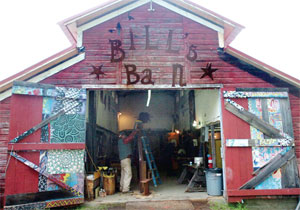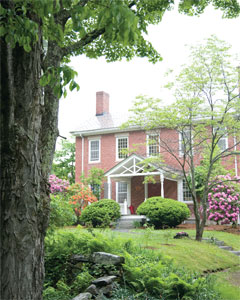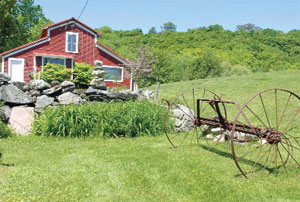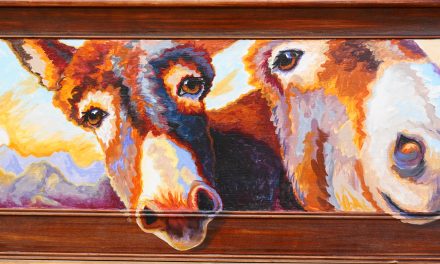 Maybe it’s the spirit of Fannie Clary or it could be the picture-perfect setting, or the highly skilled faculty or the super-motivated students or most likely all of the above. Whatever the mix, Snow Farm’s magic is evident to even a casual campus visitor. Snow Farm, originally Horizons, The New England Craft Program, was founded in 1983 by potter Jane Sinauer. Originally located in Maine, the program’s original mission was and continues to be providing high school students with a quality crafts education in a summer-camp setting. The teaching staff, comprised of highly respected craftspeople, soon drew young, crafts-focused attendees from all over the country. The availability of 50 acres, including historic eighteenth-century farm buildings, led to a move to western Massachusetts in 1986.
Maybe it’s the spirit of Fannie Clary or it could be the picture-perfect setting, or the highly skilled faculty or the super-motivated students or most likely all of the above. Whatever the mix, Snow Farm’s magic is evident to even a casual campus visitor. Snow Farm, originally Horizons, The New England Craft Program, was founded in 1983 by potter Jane Sinauer. Originally located in Maine, the program’s original mission was and continues to be providing high school students with a quality crafts education in a summer-camp setting. The teaching staff, comprised of highly respected craftspeople, soon drew young, crafts-focused attendees from all over the country. The availability of 50 acres, including historic eighteenth-century farm buildings, led to a move to western Massachusetts in 1986.
The Snow Farm campus is a blend of eighteenth-century farm buildings and structures designed by modern architects. Snow Farm’s four modern living modules are designed as a series of double rooms—each of which opens out onto a large outdoor deck. They provide living spaces for as many as 85 students. Studio spaces for about 100 are housed in the farm buildings and in a modern structure that also houses the kitchen and dining room. This all adds up to an idyllic place where creative people find the calm and quiet to develop their skills.
 At the Williamsburg campus, Sinauer continued to grow the program and strengthen its artistic and financial bases by adding other programs. A relationship she began with Elderhostel continues to flourish today. Weekend and weeklong classes were added in the spring and fall.
At the Williamsburg campus, Sinauer continued to grow the program and strengthen its artistic and financial bases by adding other programs. A relationship she began with Elderhostel continues to flourish today. Weekend and weeklong classes were added in the spring and fall.
In 2000, after nearly 20 years of camp life, Sinauer was ready for a change and announced she was selling Horizons and would focus on her cultural tourism business. Mary Colwell and her husband A. J. LaFleur had been involved with Horizons from the outset and were not comfortable with the thought that the program might end. Colwell set about putting together a group of investors and purchased the program and its campus in 2000. The new owners renamed the program Snow Farm, a reference to the last family that worked the property. Mary Colwell became the executive director, a position she held until the end of 2008. During her time at Snow Farm she added programs and oversaw major renovation projects on the campus and in studios. The kitchen was also a focal point of her attention. Colwell ensured that Snow Farm residents would be provided great, tasty, wholesome food made from fresh ingredients. Each meal reflects the same creativity and thoughtfulness that guides the entire program. In addition, formal and informal participation in the kitchen creates a real sense of community.
Karen Totman, the current executive director, sees Snow Farm as “a place for anybody to come whether they just thought about taking a particular class or if they are artists looking to expand their skill base and find inspiration, rejuvenation and escape.” Under Totman’s guidance, Snow Farm offers programs that fall into four categories. Its program is almost year-round, with over 1,000 students (some on scholarships) ages 14 to 92.
 The high school segment continues to be the centerpiece of the program. To be accepted, a student must provide reference letters and write a personal statement about what they want to do. In July, up to 85 high school students spend two or four weeks on the campus. Once on campus, the students work with master craftspeople in the two media they have chosen to study. They can choose from ceramics, drawing and color, photography, textile art, metalsmithing and jewelry construction, glassblowing, flameworking and welding. It is quite common for students to spend ten hours each day working in studios. Pat Bennett, the studios manager who also teaches welding and flameworking, says, “It’s great to teach this group because they are so interested, interesting and motivated.” Many former students have pursued higher education at arts institutions such as Rhode Island School of Design, Carnegie Mellon, and the Massachusetts College of Art, and have become professional artists and artisans.
The high school segment continues to be the centerpiece of the program. To be accepted, a student must provide reference letters and write a personal statement about what they want to do. In July, up to 85 high school students spend two or four weeks on the campus. Once on campus, the students work with master craftspeople in the two media they have chosen to study. They can choose from ceramics, drawing and color, photography, textile art, metalsmithing and jewelry construction, glassblowing, flameworking and welding. It is quite common for students to spend ten hours each day working in studios. Pat Bennett, the studios manager who also teaches welding and flameworking, says, “It’s great to teach this group because they are so interested, interesting and motivated.” Many former students have pursued higher education at arts institutions such as Rhode Island School of Design, Carnegie Mellon, and the Massachusetts College of Art, and have become professional artists and artisans.
From the outset, making the summer camp available to as many students as possible has been a goal of Snow Farm. To this end the Second’s Sale was put in place. Each November, as many as 150 artists provide their work for this sale. The proceeds from the sale provide scholarships to needy high school students attending the July program.
 Janet Weber coordinates the weeklong Elderhostel and In Depth programs that take place during 13 weeks in the late spring and early fall. Elderhostel participants must be at least 55 and are often older. The In Depth program is open to students of any age. In an interesting twist, Weber mixes up some of these classes—creating multigenerational situations. It is not uncommon to encounter young and old students in intense conversation over a meal in the dining room. The generations bond as they learn and share skills and life experiences. The intensive programs that meet for a three-day weekend allow a student to study a particular skill in depth with a master craftsman. These weekends also appeal to people of all ages and are also interesting multigenerational situations.
Janet Weber coordinates the weeklong Elderhostel and In Depth programs that take place during 13 weeks in the late spring and early fall. Elderhostel participants must be at least 55 and are often older. The In Depth program is open to students of any age. In an interesting twist, Weber mixes up some of these classes—creating multigenerational situations. It is not uncommon to encounter young and old students in intense conversation over a meal in the dining room. The generations bond as they learn and share skills and life experiences. The intensive programs that meet for a three-day weekend allow a student to study a particular skill in depth with a master craftsman. These weekends also appeal to people of all ages and are also interesting multigenerational situations.
The eastern foothills of the Berkshire Mountains create a breathtaking backdrop for the Williamsburg campus. The area surrounding the campus is known as the “Pioneer Valley.” This section of the Connecticut River valley is the home to five colleges and one of the largest concentrations of working craftspeople in the country. Snow Farm draws many faculty members from this pool and enriches the experience of the students with visits to art sites in the area.
Northampton, the home of Smith College, is close by. In addition to the resources of the college, Northampton also offers a vibrant retail and entertainment scene. The city’s carefully restored Main Street, now the focal point for the area,  is lined with small shops and restaurants. Of particular interest to the craft-minded are the four fine craft galleries and two fine art galleries. The culinary center of Northampton now has at least two restaurants per block. All this adds up to a rich intellectual, cultural and social experience, just what Fannie Clary enjoyed when she lived in the old brick farmhouse at Snow Farm. Clary actually lived in the house at the end of the nineteenth century; however, some believe she still visits—bringing with her encouragement and warm intentions.TCR
is lined with small shops and restaurants. Of particular interest to the craft-minded are the four fine craft galleries and two fine art galleries. The culinary center of Northampton now has at least two restaurants per block. All this adds up to a rich intellectual, cultural and social experience, just what Fannie Clary enjoyed when she lived in the old brick farmhouse at Snow Farm. Clary actually lived in the house at the end of the nineteenth century; however, some believe she still visits—bringing with her encouragement and warm intentions.TCR
For more information, visit www.snowfarm.org.






